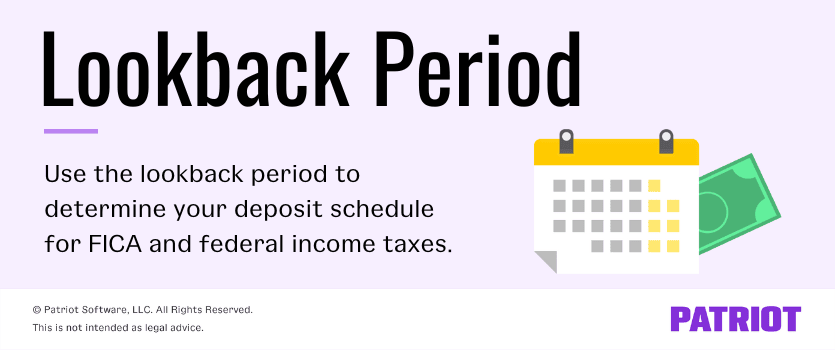Do you know how often you need to deposit federal income, Social Security, and Medicare taxes? You can’t deposit the taxes whenever you feel like. Your deposit frequency is based on a lookback period. So, what is a lookback period?
What is a lookback period?
A lookback period is the time frame employers use to figure out their deposit schedule for withheld FICA tax (Social Security and Medicare) and federal income tax. Your tax liability during the lookback period determines whether you deposit these employment taxes monthly or semiweekly. Your IRS lookback period depends on if you file Form 941 or Form 944.

About Forms 941 and 944
Before we dive into deposit schedules and lookback periods, let’s take a second to revisit Forms 941 and 944.
As an employer, you either report employee wages and payroll taxes on Form 941 or 944. You can only use Form 944 if the IRS tells you to.
Form 941, Employer’s Quarterly Federal Tax Return, is a form that employers use to report employee wages and taxes quarterly. Most employers use this form.
Form 944, Employer’s Annual Federal Tax Return, is a form that employers use to report employee wages and taxes annually. Only very small businesses use this form.
IRS payroll deposit schedule
Regardless of whether you file Form 941 or 944, you will either be a monthly or semiweekly depositor. Again, your total tax liability during the lookback period determines which schedule you must follow.
Take a look at the difference in tax liability between monthly and semiweekly depositors:
- Monthly depositor: Employers who reported a tax liability of $50,000 or less during the lookback period
- Semiweekly Depositor: Employers who reported a tax liability of more than $50,000 during the lookback period
Monthly depositors must deposit their employment taxes collected and contributed during a month by the 15th day of the following month. For example, you must deposit taxes collected in June by July 15.
Semiweekly depositors’ due dates are determined by payday. If payday falls on a Wednesday, Thursday, and/or Friday, deposit taxes by the following Wednesday. If payday falls on a Saturday, Sunday, Monday, and/or Tuesday, deposit taxes by the following Friday.
You cannot pay your liabilities based on a previous deposit schedule or how often you pay your employees. Use the lookback period to determine your deposit frequency.
Determine your deposit schedule before the beginning of each calendar year. Once you figure out your deposit schedule, use it for the whole year.
Lookback period for Forms 941 and 944
Form 941 filers use a four-quarter lookback period that starts halfway through one calendar year (July 1) and ends halfway through the next calendar year (June 30).
Form 944 filers use an annual lookback period that looks at the employer’s total tax liability during the calendar year (January – December).
But, which calendar years do you look at? Let’s get into the nitty-gritty of the IRS lookback period for Form 941 and Form 944 filers below.
What is the lookback period for Form 941 filers?
Again, Form 941 filers report their Social Security, Medicare, and federal income tax liabilities on a quarterly basis.
Form 941 filers have a four-quarter lookback period that spans from July 1 to June 30 the following year.
Let’s say you want to determine your deposit schedule for 2023. You would calculate your total tax liability from July 1, 2021 to June 30, 2022.
| Quarter 3: July 1 – September 30 (2021) |
Quarter 4: October 1 – December 31 (2021) |
Quarter 1: January 1 – March 31 (2022) |
Quarter 2: April 1 – June 30 (2022) |
| July 1 – September 30 | October 1 – December 31 | January 1 – March 31 | April 1 – June 30 |
Form 941 lookback period example
Let’s say Karen of Karen’s Pet Supply wants to know whether she’s a monthly or semiweekly depositor in 2023.
To find out Karen’s deposit schedule for 2023, we need to look at her tax liability in quarters 3 and 4 in 2021 as well as quarters 1 and 2 in 2022:
- 3rd Quarter 2020: $10,000
- 4th Quarter 2020: $10,000
- 1st Quarter 2021: $13,000
- 2nd Quarter 2021: $13,000
Karen’s total tax liability during the 2023 lookback period is $46,000. Because it is less than $50,000, Karen’s Pet Supply is a monthly depositor.
What is lookback period for Form 944 filers?
Again, Form 944 filers report Social Security, Medicare, and federal income tax liabilities on an annual basis.
If you will file Form 944 for the current year, or if you filed it in either of the previous two years, your lookback period is the second preceding calendar year. For example, the IRS lookback period for 2023 is calendar year 2021.
Depending on how you filed in the past, you might have to look at your Form 944 for that year, or all four quarters of Form 941 for that year.
Form 944 lookback period example
Let’s say Daniel of Daniel’s Hauling Services wants to find out whether he’s a monthly or semiweekly depositor for 2023. He reported the following tax liabilities on Form 944 during calendar year 2021:
- Calendar Year 2021: $1,000
Because Daniel’s tax liability was less than $50,000 in 2021, his deposit schedule for 2023 is monthly.
How adjustments affect the IRS lookback period
Mistakes happen. If you make an error on Form 941 or Form 944, you will need to make a correction using Form 941-X or Form 944-X.
If you make a correction, the adjustments don’t affect the amount of tax liability for previous periods. You must use the amount you originally reported.
Example of an adjustment
Let’s look at the 2023 lookback period for Karen’s Pet Supply again:
- 3rd Quarter 2021: $10,000
- 4th Quarter 2021: $10,000
- 1st Quarter 2022: $13,000
- 2nd Quarter 2022: $13,000
Based on this information, Karen’s Pet Supply is a monthly depositor. However, let’s say there was a mistake on Form 941 one quarter.
The second quarter of 2022, where Karen reported $13,000, should actually have been $18,000:
- 3rd Quarter 2021: $10,000
- 4th Quarter 2021: $10,000
- 1st Quarter 2022: $13,000
- 2nd Quarter 2022: $18,000
Karen can file Form 941-X to make corrections to the second quarter’s report in 2022. However, the business must use the original amount reported in the lookback period. As a result, the business remains a monthly depositor instead of changing to a semiweekly depositor.
I’m a new employer. What’s my lookback period?
If you’re a new employer, you obviously haven’t paid Social Security, Medicare, and federal income taxes before. So, your tax liabilities are considered as zeros in your lookback period.
This makes you a monthly depositor during your first year as an employer.
Before the beginning of the next calendar year, make sure you examine your lookback period. You might have some tax liability to consider.
For more information on the IRS lookback period, check out Publication 15.
Make sure your payroll taxes are always paid on time to avoid any penalties. If you use Patriot Software’s Full Service payroll, our payroll services will handle all tax filing and deposits for you. Start your free trial to say goodbye to worrying about payroll taxes!
This article has been updated from its original publication date of 4/24/2012.
This is not intended as legal advice; for more information, please click here.


